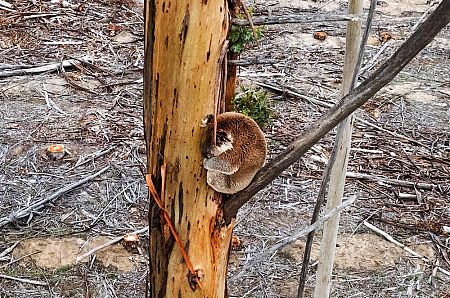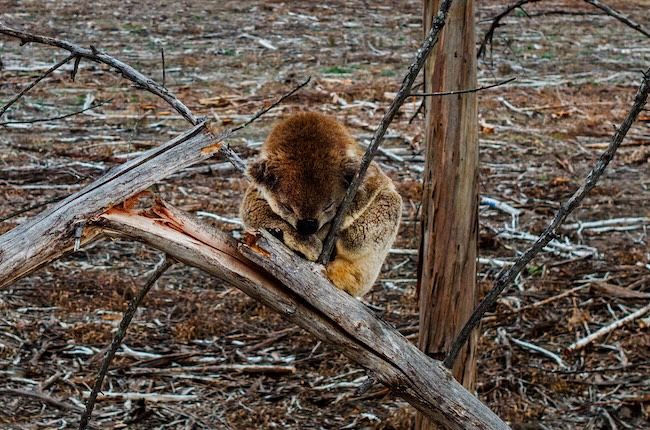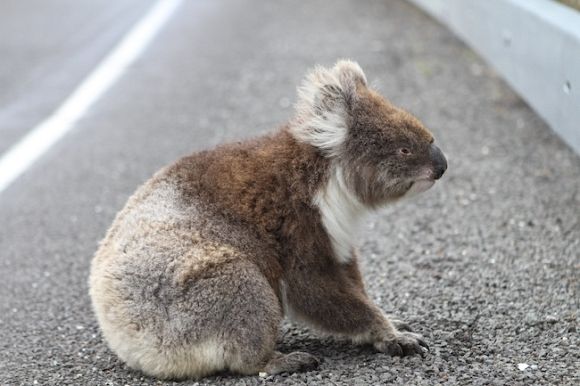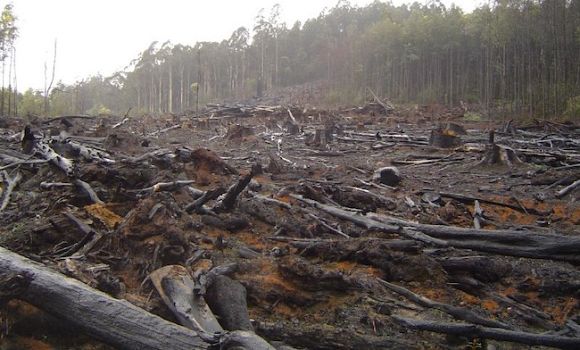Following a landslide victory, Labor will have to answer to 96% of Australians, who say more action is needed to protect the environment and native wildlife. Sue Arnold reports.
WILL LABOR USE ITS LANDSLIDE election win to address the environmental crises in Australia?
Given that neither the Labor Party, the Liberal Party, nor the Greens ensured any focus was given to critical environmental issues this election, the forecast for a responsible environmental future isn't looking good. Critical issues include the catastrophic loss of biodiversity and the ongoing logging of native forests.
In the weeks leading up to the 2025 Federal Election, the Victorian Labor Government's approval of a barbaric slaughter by helicopter shooters, which killed 1,100 koalas, was comprehensively ignored. Mainstream media failed to report the killing, raising major censorship issues, which need to be addressed.
Not a word was mentioned by Labor campaigners. Greens leader Adam Bandt, who holds the seat of Melbourne, remained silent. The state’s Greens leader remained silent. Wildlife conservation organisations, which were included in a stakeholder meeting by the Victorian Government prior to the kill, also remained silent.
Yet news of the cull was all over international media as front-page articles.
A national scandal is unfolding as the Victorian Government continues to lie, mislead and cover up its appalling slaughter, which establishes a shocking precedent for killing koalas from helicopters. It is a task involving helicopter marksmen shooting from 30 meters away with no ground truthing to ensure a fatal shot.
Paul Hilton, a recognised global conservation photojournalist, made his way to Budj Bim National Park with the intention of photographing some of the 1,100 corpses and any survivors. However, the Department of Energy, Environment and Climate Action (DEECA) closed the park, ensuring no independent inspections.
Budgi Bim National Park borders blue gum plantations. Many of the koalas killed by aerial shooting were forced into the park as a result of the harvesting of the surrounding blue gums.
Although Hilton was unable to access the park, he was able to photograph koalas struggling to survive in tiny islands of eucalypts left after the harvesting of a blue gum plantation bordering the park. He was shocked by what he saw.
Hilton said:
I’ve documented elephants losing their homes, the shark fin trade, ivory trafficking — I’ve covered a lot of destruction. At the park, I was shocked at what I saw. I couldn’t believe this was happening in Australia, at such a scale.
I went to one small area of a cleared plantation, with about 30 eucalypts left and around 20 koalas clinging to the branches. This is the scene after harvesting, koalas trying to survive in little pockets of trees.
There’s no excuse for Australia not to get it right. You can’t treat the environment like this. The mindset of culling everything in this country is a colonial mentality. Wildlife is suffering from our neglect. We have given nothing back to wildlife for all the good things they have done for us.
In 2019, the Victorian Government, led by Daniel Andrews, signed a Memorandum of Understanding (MOU) with RSPCA Victoria, ensuring the organisation could not act to protect wildlife.

An RSPCA spokesman indicated:
'As per RSPCA Victoria’s MOU with the Department, section 3.2 states RSPCA Victoria Inspectorate is not responsible for responding to animal welfare and cruelty complaints in connection with hunting activity and wildlife.'
There appears to be no opposition by RSPCA Victoria to the continuation of helicopter shootings of koalas. This operation has been run by DEECA with no involvement from RSPCA Victoria in the program.
The RSPCA spokesman further elaborated:
'We are calling on DEECA to conduct a thorough review of their program to ensure improvements and refinements are made to any future programs that may include aerial euthanasia methods in order to better protect animal welfare after extreme weather events.'
Thus far, DEECA has produced no evidence of any ethics committee approval of the kill, no details of who attended any stakeholder meetings, no information on what specialists, vets, animal welfare organisations were present, what evidence and advice were tabled.
Instead, DEECA claims it had undertaken on-ground health assessments of 2,200 koalas in the park directly impacted by the fire, which burnt approximately 2,000 hectares of land in early March.
A DEECA spokesperson said:
"Animals were individually assessed for their injuries and health and ... doing what we can to provide care to as much wildlife as possible ... All koalas have been individually assessed as part of the aerial operation.”
But how were they assessed, all 2,200 wild koalas? Answer: by helicopter.
DEECA has previously stated:
Koalas are individually assessed against set guidelines which are focused primarily on the impact of fire to their physical state and behaviour.
These assessments were undertaken as close as operationally viable, often at less than 30 metres, supported by the use of binoculars and other optical aids.
Given the downdraft of helicopters – the well-known difficulty of seeing koalas in trees – the likelihood of a clean shot is a lottery.
On the basis of the contradictory statements by DEECA, the concerned public is supposed to be assured that 2,200 koalas were either assessed on the ground or from a helicopter 30 meters away.
How many vets or skilled personnel would be required to assess the health of 2,200 koalas and how much time would it take? What kinds of assessments? What were the different methodologies required between on-ground and aerial assessments? How many were taken into care? These are all essential questions.
None of them have been answered by DEECA.
There’s no argument that blue gum plantations result in increased koala populations because of food and shelter availability. Nor has there been any disagreement about the Victorian Government's failure to address the ongoing survival of koalas post-harvesting.
Experts have suggested retaining 30% of the plantation blue gums, ensuring corridors for koala movement. The extent of current laws, plans and guidelines in place to protect koalas in Victoria can best be described as completely ineffective, whether they are forests, plantations or urban development habitats.
Increasingly, the Victorian Government’s environmental policies could be described as a basket case.
A recent study by Professor David Lindenmayer has quantified evidence on the extent of regeneration following logging in the eucalypt forests of southeastern Australia. Nearly 20% of logged areas failed to regenerate.
A survey conducted by the Biodiversity Council in March indicated an overwhelming 86% of Australians are concerned about the decline of native animals and plants in their local areas, highlighting that environmental concerns are both a local and national issue.
The survey showed 96% of Australians believe more action is needed to look after the natural environment and 95% believe more of the Federal Budget should be dedicated to nature protection. The possible extinction of native animals was among the top three concerns for Australians.
The Victorian Government issued a regulatory guide called 'Minimising Impacts to Koalas in Blue Gum Plantations' in 2023.
The guide states:
'Retaining a minimum of nine live trees per koala spotted to provide sufficient browse and protection for the koala until it can find its own way out of the area safely.'
On his visit to the blue gum plantation, Hilton was accompanied by veteran koala conservationist and Queensland Koala Crusaders (QKC) co-founder, Meghan Halverson. Together, they made their way along the border between the park and a harvested plantation area, observing koalas and the situation they now face, struggling to survive in tiny islands of trees.
Her poignant words sum up the heartbreak and concern of thousands of people, both in Australia and internationally. She was devastated by the sight of koalas clinging to poorly leafed trees.
Halverson said:
“This one koala looked me in the eye, looking into my soul. He looked at me the whole time. All I could say was, 'I’m so, so sorry'.”
Sue Arnold is an IA columnist and freelance investigative journalist. You can follow Sue on Twitter @koalacrisis.
 This work is licensed under a Creative Commons Attribution-NonCommercial-NoDerivs 3.0 Australia License
This work is licensed under a Creative Commons Attribution-NonCommercial-NoDerivs 3.0 Australia License
Support independent journalism Subscribe to IA.














